QML-Chartview
一、例子
1、例子1:基本使用
import QtQuick 2.0 import QtCharts 2.2 Rectangle { id: root property string info: "info" color: "#000C3C" width: 600; height: 400; function setValue(list_y,txt) { root.info = txt; spline.clear(); axisY.min = Math.min.apply(null,list_y) axisY.max = Math.max.apply(null,list_y) for(var i=0;i<list_y.length;i++) { spline.append(i,list_y[i]); } } ChartView { id:chartView width: 0.66*parent.width height: parent.height backgroundColor: "#000C3C" ValueAxis { id: axisX min: 0 max: 10 labelsVisible: false gridVisible: false visible: false } ValueAxis { id: axisY labelsColor: "white" gridLineColor: "#3379B7" titleText: "取值趋向" } LineSeries { id:spline; axisX: axisX axisY: axisY color:"red" name: "参数分析" width:1 pointsVisible: true } } Text { id: text color: "white" font.pixelSize: 15; anchors.left: chartView.right width: 0.34*parent.width height: parent.height text: root.info wrapMode: Text.Wrap verticalAlignment:Text.AlignVCenter // Component.onCompleted: { // text.text = "参数名:xxx\n经分析2000.01.01~2020.01.01的数据, //发现参数取值总体呈现上升趋势,出厂阈值为100~200,实际阈值为150~180, //最大取值:190,最小取值:129,最可能取值:148\n2020.05.01"; // } } }
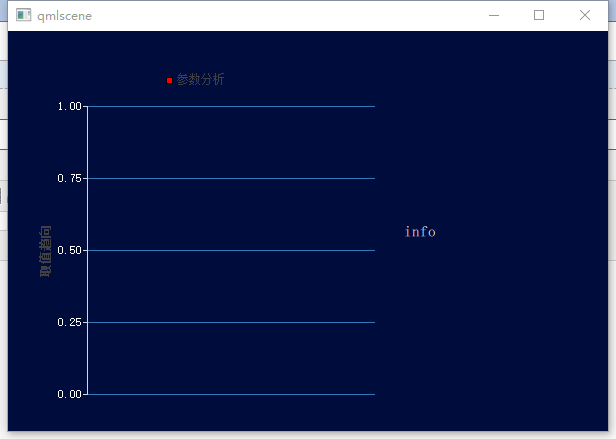
2、例子2:缩放等
import QtQuick 2.0 import QtCharts 2.2 Rectangle { id: root property string info: "info" color: "green" width: 600; height: 400; MouseArea { hoverEnabled: true anchors.fill: parent; onClicked: { console.log("MouseArea") } propagateComposedEvents: true onPressed: { mouse.accpted = false } } ChartView { id:chartView title: "XXX数据源" antialiasing: true backgroundColor: "#9917719b" titleColor: "#ccffffff" titleFont.bold: true titleFont.family: "方正粗倩_GBK" titleFont.pointSize: 15 anchors.centerIn: parent; // width: 200; // height: 200; anchors.fill: parent LineSeries { name: "LineSeries" XYPoint { x: 0; y: 0 } XYPoint { x: 1.1; y: 2.1 } XYPoint { x: 1.9; y: 3.3 } XYPoint { x: 2.1; y: 2.1 } XYPoint { x: 2.9; y: 4.9 } XYPoint { x: 3.4; y: 3.0 } XYPoint { x: 4.1; y: 3.3 } onHovered: { console.log("LineSeries") } } MouseArea{ id:mouseArea anchors.fill: parent property int currentX:0 property int currentY: 0 onWheel: {//图形缩放 if(wheel.angleDelta.y>0){ chartView.zoom(1.1) chartView.scrollRight(40) } else{ chartView.zoom(0.9) } } onPressed: {//获取点击时位置 mouseArea.cursorShape = Qt.ClosedHandCursor currentX = mouse.x currentY = mouse.y } onReleased: { mouseArea.cursorShape = Qt.ArrowCursorArrowCursor } onPositionChanged:{//拖拽功能实现 var moveX = mouse.x-currentX var moveY = mouse.y-currentY currentX = mouse.x currentY = mouse.y chartView.scrollLeft(moveX) chartView.scrollUp(moveY) } } } }

3、添加标记实时更新
import QtQuick 2.0 import QtQuick.Layouts 1.15 import QtCharts 2.15 ChartView { id: id_chart width: 500; height: 400 ValueAxis { id: id_baseAxisX tickCount: 11 labelsVisible: false gridLineColor: /*"#B5C2B9"*/"gray" lineVisible: false //突出的小段线不可见 min: 0 max: 1000 tickInterval: 1 } ValueAxis { id: id_baseAxisY tickCount: 11 labelsVisible: false gridLineColor: /*"#B5C2B9"*/"gray" lineVisible: false min: 0; max: 80 } LineSeries { id:testLine name: "LineSeries" axisX: id_baseAxisX axisY: id_baseAxisY XYPoint { x: 0; y: 0 } XYPoint { x: 110; y: 21 } XYPoint { x: 190; y: 33 } XYPoint { x: 210; y: 21 } XYPoint { x: 290; y: 49 } XYPoint { x: 340; y: 30 } XYPoint { x: 410; y: 33 } } Rectangle { id: rect width: 10 height: 10 radius: 5 color: "red" } Timer { interval: 1000 repeat: true running: true onTriggered: { var p = id_chart.mapToPosition(testLine.at(3), testLine) rect.x = p.x-rect.width/2 rect.y = p.y-rect.height/2 } } }
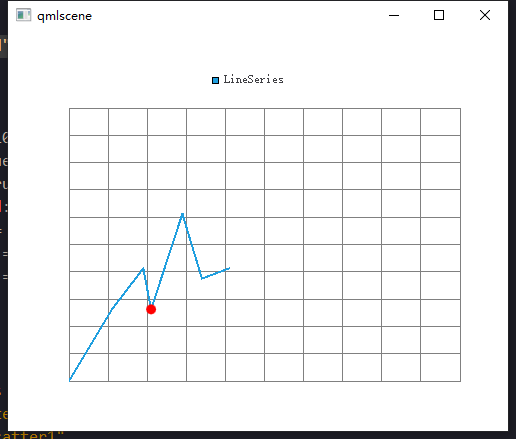
二、相关继承图
①、视图
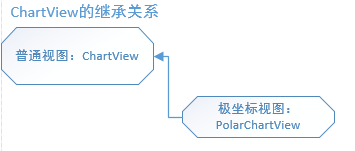
②、图形系列
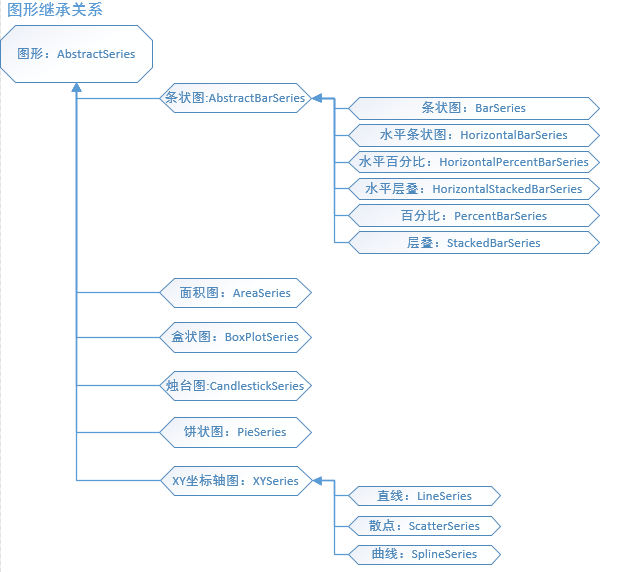
③、坐标轴

PS:
1、问题:在QML里加入了ChartView运行程序崩溃,将main.cpp里的QGuiApplication改成QApplication。
2、问题:使用QValueAxis时,报错:error: expected class-name,在开头加上QT_CHARTS_USE_NAMESPACE: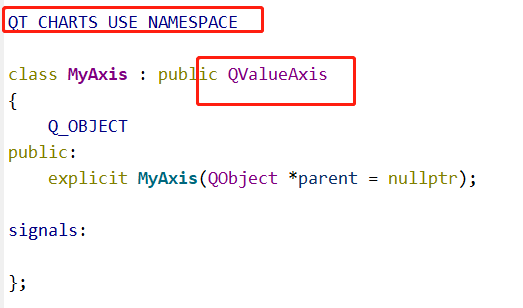
3、触摸屏的使用:PinchArea
https://stackoverflow.com/questions/50050391/how-to-set-zoom-origin-for-a-qml-chart-view
4、设置绘制区域
id_chart.plotArea = Qt.rect(id_chart.x,id_chart.y,id_chart.width,id_chart.height)
这个函数有个bug,需要重新设置宽度或高度,才会触发自绘,相关见官方:https://bugreports.qt.io/browse/QTBUG-95870
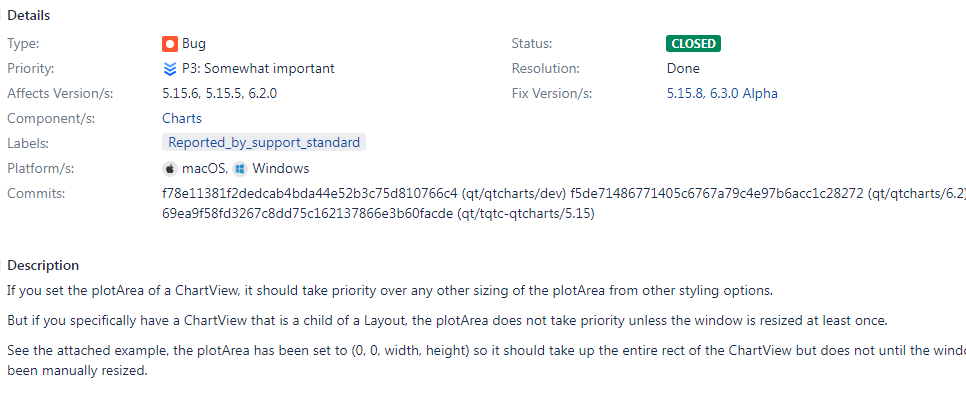
5、在C++中访问ChartView的线
①、方法1:通过查找chartview对象然后调用函数
QObject* chartview = viewer.rootObject()->findChild<QObject*>("myChartView"); //points to chartview object from QML QAbstractSeries* series; //will point to PieSeries or LineSeries in ChartView once invokeMethod returns it QMetaObject::invokeMethod(chartview, "series", Qt::AutoConnection, Q_RETURN_ARG(QAbstractSeries*, series), Q_ARG(int, 0)); //Get first series in ChartView; series method expect an integer
②、方法2:在C++中设置函数接口,在QML中调用传入line对象
//C++ Q_INVOKABLE void bindLine(QtCharts::QAbstractSeries* line) { QtCharts::QLineSeries* s = static_case<QtCharts::QLineSeries>(line); QVector<QPointf> pts; //add points to pts s.replace(pts); } //QML LineSeries { id: line Component.onComplect { bindLine(line); } }
6、动态创建线
接口:ChartView.createSeries
7、为线添加点时,是按照x从小到大绘制的,如果某个点的x值比前一个点的x大,则此点被忽略
import QtQuick 2.0 import QtQuick.Layouts 1.15 import QtCharts 2.15 ChartView { id: id_chart width: 500; height: 400 ValueAxis { id: id_baseAxisX tickCount: 11 labelsVisible: false gridLineColor: /*"#B5C2B9"*/"gray" lineVisible: false //突出的小段线不可见 min: 0 max: 1000 tickInterval: 1 } ValueAxis { id: id_baseAxisY tickCount: 11 labelsVisible: false gridLineColor: /*"#B5C2B9"*/"gray" lineVisible: false min: 0; max: 80 } ScatterSeries { id: scatter1 name: "Scatter1" axisX: id_baseAxisX axisY: id_baseAxisY XYPoint { x: 15; y: 15 } XYPoint { x: 115; y: 15 } XYPoint { x: 20; y: 15 }//会被忽略 } }

如果不指定y轴,则效果是:
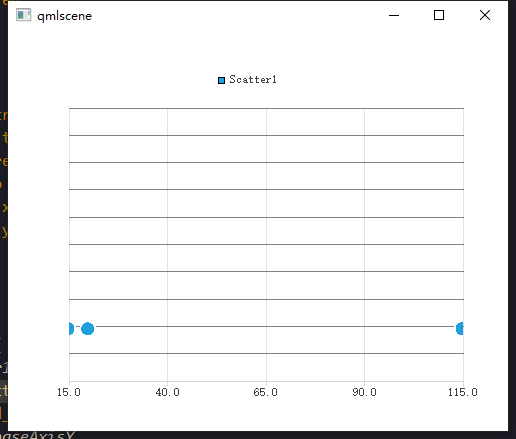
8、chart坐标系和qml坐标系的转换
/* *描述:根据chart坐标系上的一个点转化为chart所在的qt坐标系点 *参数1:[NULL] 参数2:[NULL] *返回:NULL *作者:zhuxy */ function getQMLPositionFromChart(chartPoint) { console.assert(id_chart.count>0, "chart series count is 0"); return id_chart.mapToPosition(chartPoint, id_chart.series(0)); } /* *描述:根据qt坐标系点转化为chart所在的坐标系点 *参数1:[NULL] 参数2:[NULL] *返回:NULL *作者:zhuxy */ function getChartPositionFromQML(qmlPoint) { console.assert(id_chart.count>0, "chart series count is 0"); return id_chart.mapToValue(qmlPoint, id_chart.series(0)); }
长风破浪会有时,直挂云帆济沧海!
可通过下方链接找到博主
https://www.cnblogs.com/judes/p/10875138.html





